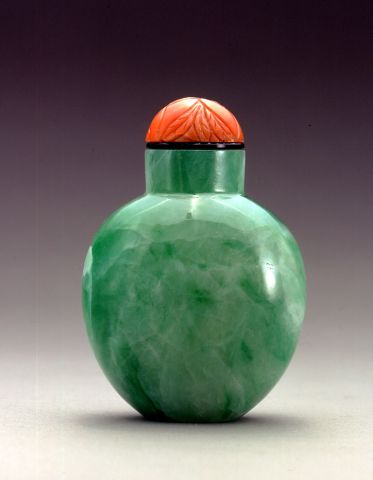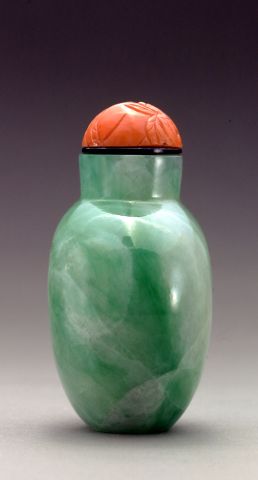

Bottle ID: 493
APPLE GREEN WITH WHITE STREAKS, BULBOUS
Date: 1780-1850
Height: 55 mm
Jadeite, very well hollowed, of rounded bulbous form, the translucent stone with icy white and vivd apple green mottled tones.
Similar Examples:
Stevens, Bob C. The Collector's Book of Snuff Bottles, 1976, p. 123, no. 449.
Hall, Robert. Chinese Snuff Bottles: Masterpieces from the Rietberg Museum, Zurich, 1993, pp. 52-53, no. 20.
Chan Lin-sheng. Snuff Bottles in the Collection of the National Palace Museum Taipei, Taiwan, 1991, p. 180, no. 204.
Lawrence, Clare. The Alexander Brody Collection of Chinese Snuff Bottles, 1995, p. 51, no. 72.
Provenance:
Asian Art Studio
Bonhams & Butterfields, November 4, 2003, lot 3315
Irma Grabhorn, San Francisco, CA
It was the French chemist Augustine Alexis Damour, who first brought into the West the idea that under the generic label of jade were two distinct minerals: nephrite and jadeite. In 1860 Comte Klaczkowsky was present at the sacking of the Summer Palace in Beijing, and he returned to Paris with some unusual looking emerald green jades that he had looted. The ceramics expert Albert Jules Jacquemart pronounced them to be "jade imperial", reminding him of the green enamel colour present on the Imperial Chinese porcelains that he had seen. Damour, a couple of years later, in 1863, realized that it was not nephrite (a term coined by the Germans in 1789) and renamed it jadeite, as he considered it to resemble the piedra de ijada, "the stone of the loin" of Aztec and Maya carvings. It was towards the end of the eighteenth century that good quality jadeite was imported into China in any decent quantity. Initially the Chinese traders brought it directly across the Burmese borders, although after 1780 supplies became dependable via regular traffic through Guangzhou. The Qianlong Emperor, fond as he was of nephrite, loved the brilliant greens in jadeite and paid dearly to obtain it.
< Back to full list

 English
English 中文
中文